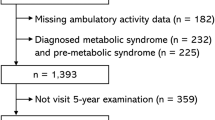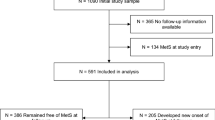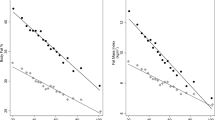Abstract
Objective
To examine the independent and joint associations between physical activity (PA) timing and volume patterns in relation to metabolic syndrome (MetS).
Methods
Data from the NHANES 2011–2014 cycles, involving 5065 participants, were used. PA was measured using triaxial accelerometers. PA timing patterns were determined using the K-means clustering algorithm, and PA volumes were categorized based on tertiles (low, moderate, and high). Logistic regression models were used to assess the associations between PA patterns and MetS and its components. We also used restricted cubic spline curves to fit the PA to the MetS and its component non-linear associations.
Results
Three distinct PA timing patterns were identified using K-means clustering (morning, midday-afternoon, and late afternoon-evening). Independent analyses indicated that engaging in PA during the morning or midday-afternoon PA was with lower odds of MetS compared to late afternoon-evening. The adjusted odds ratios (95% confidence intervals) were 0.79 (0.63–0.99) and 0.78 (0.62–0.98), respectively. In joint analyses, compared with the late afternoon-evening/low PA pattern, the morning and midday-afternoon PA timing patterns were associated with lower odds of MetS when combined with moderate or high PA volume. In contrast, the late afternoon-evening PA pattern was significantly associated with lower odds of MetS only at high PA volumes. Additionally, a nonlinear association with MetS was identified in the morning PA pattern, whereas dose-dependent associations with MetS were observed in the midday-afternoon and late afternoon-evening PA patterns.
Conclusions
Our study shows that morning and midday-afternoon PA patterns are associated with lower odds of MetS compared to late afternoon-evening PA. Higher total PA volume is also linked with lower odds of MetS. Conversely, prolonged PA during the late evening or nighttime is associated with higher odds of poorer metabolic outcomes.
This is a preview of subscription content, access via your institution
Access options
Subscribe to this journal
Receive 12 print issues and online access
$259.00 per year
only $21.58 per issue
Buy this article
- Purchase on SpringerLink
- Instant access to full article PDF
Prices may be subject to local taxes which are calculated during checkout



Similar content being viewed by others
Data availability
This study was conducted using publicly available data from the National Health and Nutrition Examination Survey (https://www.cdc.gov/nchs/nhanes/). The analysis code is available from the corresponding author upon reasonable request.
References
Cornier MA, Dabelea D, Hernandez TL, Lindstrom RC, Steig AJ, Stob NR, et al. The metabolic syndrome. Endocr Rev. 2008;29:777–822. https://doi.org/10.1210/er.2008-0024.
Ford ES. Risks for all-cause mortality, cardiovascular disease, and diabetes associated with the metabolic syndrome: a summary of the evidence. Diab Care. 2005;28:1769–78. https://doi.org/10.2337/diacare.28.7.1769.
Lee JA, Yoo JE, Park HS. Metabolic syndrome and incidence of breast cancer in middle-aged Korean women: a nationwide cohort study. Breast Cancer Res Treat. 2017;162:389–93. https://doi.org/10.1007/s10549-017-4131-x.
Li W, Chen D, Peng Y, Lu Z, Kwan MP, Tse LA. Association between metabolic syndrome and mortality: prospective cohort study. JMIR Public Health Surveill. 2023;9:e44073 https://doi.org/10.2196/44073.
Saklayen MG. The global epidemic of the metabolic syndrome. Curr Hypertens Rep. 2018;20:12 https://doi.org/10.1007/s11906-018-0812-z.
Hirode G, Wong RJ. Trends in the prevalence of metabolic syndrome in the United States, 2011-2016. JAMA. 2020;323:2526–8. https://doi.org/10.1001/jama.2020.4501.
Zhang D, Liu X, Liu Y, Sun X, Wang B, Ren Y, et al. Leisure-time physical activity and incident metabolic syndrome: a systematic review and dose-response meta-analysis of cohort studies. Metabolism. 2017;75:36–44. https://doi.org/10.1016/j.metabol.2017.08.001.
Rennie KL, McCarthy N, Yazdgerdi S, Marmot M, Brunner E. Association of the metabolic syndrome with both vigorous and moderate physical activity. Int J Epidemiol. 2003;32:600–6. https://doi.org/10.1093/ije/dyg179.
Li H, Lynn HS, Zipunnikov V. Sex and age differences in association between physical activity and metabolic syndrome: results from NHANES 2003-2006. Healthcare. 2023:11. https://doi.org/10.3390/healthcare11081059.
Seo MW, Eum Y, Jung HC. Leisure time physical activity: a protective factor against metabolic syndrome development. BMC Public Health. 2023;23:2449. https://doi.org/10.1186/s12889-023-17340-w.
Grilo CM. Physical activity and obesity. Biomed Pharmacother. 1994;48:127–36. https://doi.org/10.1016/0753-3322(94)90101-5.
Berge J, Hjelmesaeth J, Hertel JK, Gjevestad E, Småstuen MC, Johnson LK, et al. Effect of aerobic exercise intensity on energy expenditure and weight loss in severe obesity-a randomized controlled trial. Obesity. 2021;29:359–69. https://doi.org/10.1002/oby.23078.
Lechner K, Kia S, von Korn P, Dinges SM, Mueller S, Tjønna AE, et al. Cardiometabolic and immune response to exercise training in patients with metabolic syndrome: retrospective analysis of two randomized clinical trials. Front Cardiovasc Med. 2024;11:1329633. https://doi.org/10.3389/fcvm.2024.1329633.
Albalak G, Stijntjes M, Wijsman CA, Slagboom PE, van der Ouderaa FJ, Mooijaart SP, et al. Timing of objectively-collected physical activity in relation to body weight and metabolic health in sedentary older people: a cross-sectional and prospective analysis. Int J Obes. 2022;46:515–22. https://doi.org/10.1038/s41366-021-01018-7.
Fukuoka Y, Zhou M, Vittinghoff E, Haskell W, Goldberg K, Aswani A. Objectively measured baseline physical activity patterns in women in the mPED trial: cluster analysis. JMIR Public Health Surveill. 2018;4:e10 https://doi.org/10.2196/publichealth.9138.
Brito LC, Peçanha T, Fecchio RY, Rezende RA, Sousa P, DA Silva-Júnior N, et al. Morning versus evening aerobic training effects on blood pressure in treated hypertension. Med Sci Sports Exerc. 2019;51:653–62. https://doi.org/10.1249/mss.0000000000001852.
Janssen I, Campbell JE, Zahran S, Saunders TJ, Tomasone JR, Chaput JP. Timing of physical activity within the 24-hour day and its influence on health: a systematic review. Health Promot Chronic Dis Prev Can. 2022;42:129–38. https://doi.org/10.24095/hpcdp.42.4.02.
Lee HA, Lee HJ, Moon JH, Lee T, Kim MG, In H, et al. Comparison of wearable activity tracker with actigraphy for sleep evaluation and circadian rest-activity rhythm measurement in healthy young adults. Psychiatry Investig. 2017;14:179–85. https://doi.org/10.4306/pi.2017.14.2.179.
Smagula SF, Stahl ST, Krafty RT, Buysse DJ. Initial proof of concept that a consumer wearable can be used for real-time rest-activity rhythm monitoring. Sleep. 2022;45. https://doi.org/10.1093/sleep/zsab288
Li J, Somers VK, Lopez-Jimenez F, Di J, Covassin N. Demographic characteristics associated with circadian rest-activity rhythm patterns: a cross-sectional study. Int J Behav Nutr Phys Act. 2021;18:107. https://doi.org/10.1186/s12966-021-01174-z.
Belcher BR, Wolff-Hughes DL, Dooley EE, Staudenmayer J, Berrigan D, Eberhardt MS, et al. US population-referenced percentiles for wrist-worn accelerometer-derived activity. Med Sci Sports Exerc. 2021;53:2455–64. https://doi.org/10.1249/mss.0000000000002726.
John D, Tang Q, Albinali F, Intille S. An open-source monitor-independent movement summary for accelerometer data processing. J Meas Phys Behav. 2019;2:268–81. https://doi.org/10.1123/jmpb.2018-0068.
Leroux A, Cui E, Smirnova E, Muschelli J, Schrack JA, Crainiceanu CM. NHANES 2011-2014: objective physical activity is the strongest predictor of all-cause mortality. Med Sci Sports Exerc. 2024;56:1926–34. https://doi.org/10.1249/mss.0000000000003497.
You J, Long J, Wang Z, Yang Y. Associations of physical activity volume and intensity with depression symptoms among US adults. Front Public Health. 2025;13:1592961. https://doi.org/10.3389/fpubh.2025.1592961.
Wu J, Wang Y, Qiu P, Li Y. Associations of exercise snacks with cognitive function among older adults in NHANES 2011-2014. Gen Hosp Psychiatry. 2025;94:167–73. https://doi.org/10.1016/j.genhosppsych.2025.03.005.
Xiao Q, Feng Q, Rutter MK, Albalak G, Wang H, Noordam R. Associations between the timing of 24 h physical activity and diabetes mellitus: results from a nationally representative sample of the US population. Diabetologia. 2025;68:1005–15. https://doi.org/10.1007/s00125-025-06368-9.
Zheng P, Pleuss JD, Turner DS, Ducharme SW, Aguiar EJ. Dose-response association between physical activity (daily MIMS, peak 30-minute MIMS) and cognitive function among older adults: NHANES 2011-2014. J Gerontol A Biol Sci Med Sci. 2023;78:286–91. https://doi.org/10.1093/gerona/glac076.
Zhang Y, Kivimäki M, Carrillo-Larco RM, Cheng Y, Zhou Y, Wang H, et al. Diurnal patterns of accelerometer-measured physical activity and sleep and risk of all-cause mortality: a follow-up of the National Health and Nutrition Examination Surveys (NHANES). Int J Behav Nutr Phys Act. 2024;21:120. https://doi.org/10.1186/s12966-024-01673-9.
Hughes RL, Pindus DM, Khan NA, Burd NA, Holscher HD. Associations between accelerometer-measured physical activity and fecal microbiota in adults with overweight and obesity. Med Sci Sports Exerc. 2023;55:680–9. https://doi.org/10.1249/mss.0000000000003096.
Ma T, Bennett T, Lee CD, Wicklow M. The diurnal pattern of moderate-to-vigorous physical activity and obesity: a cross-sectional analysis. Obesity. 2023;31:2638–47. https://doi.org/10.1002/oby.23851.
Grundy SM, Cleeman JI, Daniels SR, Donato KA, Eckel RH, Franklin BA, et al. Diagnosis and management of the metabolic syndrome: an American Heart Association/National Heart, Lung, and Blood Institute Scientific Statement. Circulation. 2005;112:2735–52. https://doi.org/10.1161/circulationaha.105.169404.
Du L, Li T, Xue X, He Q, Pan Y, Chen S, et al. Independent and joint role of inflammatory diet and physical activity with cognitive function in aging: Evidence from a population-based survey. Gen Hosp Psychiatry. 2024;91:52–59. https://doi.org/10.1016/j.genhosppsych.2024.09.003.
Krittanawong C, Tunhasiriwet A, Wang Z, Zhang H, Farrell AM, Chirapongsathorn S, et al. Association between short and long sleep durations and cardiovascular outcomes: a systematic review and meta-analysis. Eur Heart J Acute Cardiovasc Care. 2019;8:762–70. https://doi.org/10.1177/2048872617741733.
Frimpong E, Mograss M, Zvionow T, Dang-Vu TT. The effects of evening high-intensity exercise on sleep in healthy adults: a systematic review and meta-analysis. Sleep Med Rev. 2021;60:101535. https://doi.org/10.1016/j.smrv.2021.101535.
Stein MJ, Weber A, Bamberg F, Baurecht H, Berger K, Bohmann P, et al. Diurnal timing of physical activity in relation to obesity and diabetes in the German National Cohort (NAKO). Int J Obes. 2025;49:921–30. https://doi.org/10.1038/s41366-025-01721-9.
van der Velde J, Boone SC, Winters-van Eekelen E, Hesselink MKC, Schrauwen-Hinderling VB, Schrauwen P, et al. Timing of physical activity in relation to liver fat content and insulin resistance. Diabetologia. 2023;66:461–71. https://doi.org/10.1007/s00125-022-05813-3.
Mancilla R, Brouwers B, Schrauwen-Hinderling VB, Hesselink MKC, Hoeks J, Schrauwen P. Exercise training elicits superior metabolic effects when performed in the afternoon compared to morning in metabolically compromised humans. Physiol Rep. 2021;8:e14669. https://doi.org/10.14814/phy2.14669.
Savikj M, Gabriel BM, Alm PS, Smith J, Caidahl K, Björnholm M, et al. Afternoon exercise is more efficacious than morning exercise at improving blood glucose levels in individuals with type 2 diabetes: a randomised crossover trial. Diabetologia. 2019;62:233–7. https://doi.org/10.1007/s00125-018-4767-z.
DiPietro L, Gribok A, Stevens MS, Hamm LF, Rumpler W. Three 15-min bouts of moderate postmeal walking significantly improves 24-h glycemic control in older people at risk for impaired glucose tolerance. Diab Care. 2013;36:3262–8. https://doi.org/10.2337/dc13-0084.
Kim HK, Furuhashi S, Takahashi M, Chijiki H, Nanba T, Inami T, et al. Late-afternoon endurance exercise is more effective than morning endurance exercise at improving 24-h glucose and blood lipid levels. Front Endocrinol. 2022;13:957239. https://doi.org/10.3389/fendo.2022.957239.
Amaro-Gahete FJ, Jurado-Fasoli L, Triviño AR, Sanchez-Delgado G, De-la OA, Helge JW, et al. Diurnal variation of maximal fat-oxidation rate in trained male athletes. Int J Sports Physiol Perform. 2019;14:1140–6. https://doi.org/10.1123/ijspp.2018-0854.
Chomistek AK, Shiroma EJ, Lee IM. The relationship between time of day of physical activity and obesity in older women. J Phys Act Health. 2016;13:416–8. https://doi.org/10.1123/jpah.2015-0152.
Iwayama K, Kurihara R, Nabekura Y, Kawabuchi R, Park I, Kobayashi M, et al. Exercise increases 24-h fat oxidation only when it is performed before breakfast. EBioMedicine. 2015;2:2003–9. https://doi.org/10.1016/j.ebiom.2015.10.029.
Aoyama S, Shibata S. Time-of-day-dependent physiological responses to meal and exercise. Front Nutr. 2020;7:18 https://doi.org/10.3389/fnut.2020.00018.
Iwayama K, Kawabuchi R, Nabekura Y, Kurihara R, Park I, Kobayashi M, et al. Exercise before breakfast increases 24-h fat oxidation in female subjects. PLoS One. 2017;12:e0180472 https://doi.org/10.1371/journal.pone.0180472.
Marsh ML, Oliveira MN, Vieira-Potter VJ. Adipocyte metabolism and health after the menopause: the role of exercise. Nutrients. 2023;15. https://doi.org/10.3390/nu15020444
Mauvais-Jarvis F, Clegg DJ, Hevener AL. The role of estrogens in control of energy balance and glucose homeostasis. Endocr Rev. 2013;34:309–38. https://doi.org/10.1210/er.2012-1055.
Donahoo WT, Levine JA, Melanson EL. Variability in energy expenditure and its components. Curr Opin Clin Nutr Metab Care. 2004;7:599–605. https://doi.org/10.1097/00075197-200411000-00003.
Diaz-Canestro C, Montero D. Sex dimorphism of VO(2max) trainability: a systematic review and meta-analysis. Sports Med. 2019;49:1949–56. https://doi.org/10.1007/s40279-019-01180-z.
Vasey C, McBride J, Penta K. Circadian rhythm dysregulation and restoration: the role of melatonin. Nutrients, 2021;13. https://doi.org/10.3390/nu13103480
Refinetti R. The circadian rhythm of body temperature. Front Biosci. 2010;15:564–94. https://doi.org/10.2741/3634.
Jones PJ, Schoeller DA. Evidence for diurnal periodicity in human cholesterol synthesis. J Lipid Res. 1990;31:667–73.
Bremner WF, Sothern RB, Kanabrocki EL, Ryan M, McCormick JB, Dawson S, et al. Relation between circadian patterns in levels of circulating lipoprotein(a), fibrinogen, platelets, and related lipid variables in men. Am Heart J. 2000;139:164–73. https://doi.org/10.1016/s0002-8703(00)90324-7.
Stenvers DJ, Scheer F, Schrauwen P, la Fleur SE, Kalsbeek A. Circadian clocks and insulin resistance. Nat Rev Endocrinol. 2019;15:75–89. https://doi.org/10.1038/s41574-018-0122-1.
Martinez-Amezcua P, Dooley EE, Reed NS, Powell D, Hornikel B, Golub JS, et al. Association of hearing impairment and 24-hour total movement activity in a representative sample of US adults. JAMA Netw Open. 2022;5:e222983 https://doi.org/10.1001/jamanetworkopen.2022.2983.
Author information
Authors and Affiliations
Contributions
QW was responsible for conceptualization, data curation, formal analysis, visualization, and writing the original draft. BS, LD, WJ, and JC contributed to methodology development and supervision. XX, YP, SC, and XZ participated in conceptualization and methodology design. QH contributed to conceptualization, methodology development, and reviewing and editing the manuscript.
Corresponding author
Ethics declarations
Competing interests
The authors declare no competing interests.
Ethical approval and consent to participate
All methods were performed in accordance with the relevant guidelines and regulations. The study protocol for the US NHANES was approved by the US NHANES institutional review board and National Center for Health Statistics Research ethics review board (Protocol #2011-17). All participants provided written informed consent. Institutional review board approval was exempted for this study because of the publicly available and deidentified data.
Additional information
Publisher’s note Springer Nature remains neutral with regard to jurisdictional claims in published maps and institutional affiliations.
Supplementary information
Rights and permissions
Springer Nature or its licensor (e.g. a society or other partner) holds exclusive rights to this article under a publishing agreement with the author(s) or other rightsholder(s); author self-archiving of the accepted manuscript version of this article is solely governed by the terms of such publishing agreement and applicable law.
About this article
Cite this article
Wu, Q., Shi, B., Du, L. et al. Diurnal timing and volume of physical activity in relation to metabolic syndrome in US adults: a population-based cohort study. Int J Obes (2025). https://doi.org/10.1038/s41366-025-01893-4
Received:
Revised:
Accepted:
Published:
DOI: https://doi.org/10.1038/s41366-025-01893-4



